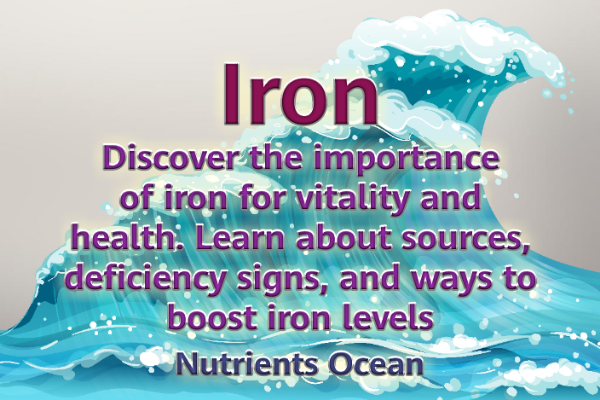Iron
In the bustling rhythm of modern life, amidst the myriad of health trends and superfoods, one essential mineral often goes overlooked: iron. Yet, its significance to our overall well-being cannot be overstated. From bolstering energy levels to supporting cognitive function, iron plays a pivotal role in maintaining optimal health. Let's delve into the importance and myriad benefits of iron, as well as how to identify and address its deficiency.The Vital Role of Iron
Iron serves as a fundamental building block within our bodies, contributing to various physiological processes. One of its primary functions is aiding in the production of haemoglobin, the protein responsible for transporting oxygen in the blood. This oxygenation process is crucial for sustaining energy levels, promoting cell growth, and supporting cognitive function.
Health Benefits of Iron
1. Enhanced Energy Levels:
Iron facilitates the efficient transport of oxygen to cells and tissues, promoting vitality and reducing fatigue.
2. Optimised Cognitive Function:
Adequate iron levels support brain health, aiding in cognitive processes such as concentration, memory, and overall mental alertness.
3. Boosted Immune System:
Iron plays a role in immune function, helping the body defend against infections and illnesses by promoting the production of white blood cells.
4. Regulated Body Temperature:
Iron contributes to the regulation of body temperature, ensuring optimal thermoregulation and preventing overheating or excessive cooling.
Food Sources of Iron
Here's a list of food and natural sources of iron along with brief explanations of each:
1. Red Meat:
Beef and lamb are rich sources of heme iron, which is easily absorbed by the body. Incorporating lean cuts of red meat into your diet can help boost iron intake.
2. Poultry:
Chicken and turkey provide a good source of heme iron, along with essential proteins. Including poultry in your meals can contribute to meeting your iron requirements.
3. Fish and Seafood:
Certain types of fish, such as tuna, salmon, and shellfish like clams and oysters, contain iron, making them nutritious additions to your diet.
4. Legumes:
Beans, lentils, and chickpeas are excellent plant-based sources of iron. They also offer fiber, protein, and other essential nutrients, making them ideal for vegetarians and vegans.
5. Tofu and Soy Products:
Tofu, tempeh, and soybeans are rich in iron and serve as versatile options for plant-based meals. Incorporating these soy-based products can help meet your iron needs.
6. Leafy Greens:
Spinach, kale, and Swiss chard are packed with non-heme iron, along with other vitamins and minerals. Adding leafy greens to salads, smoothies, or stir-fries can boost your iron intake.
7. Nuts and Seeds:
Almonds, pumpkin seeds, and sesame seeds are nutritious sources of iron. Snacking on nuts and seeds or incorporating them into meals and snacks can provide a iron-rich boost.
8. Fortified Foods:
Certain foods, such as fortified cereals, bread, and pasta, are enriched with iron and other nutrients. Opting for fortified products can help increase your iron intake, especially if you have specific dietary restrictions.
9. Dried Fruits:
Raisins, apricots, and prunes are concentrated sources of iron, making them convenient snacks or additions to cereals, salads, and baked goods.
10. Dark Chocolate:
Indulging in moderate amounts of dark chocolate can contribute to your iron intake. Opt for varieties with higher cocoa content for maximum benefits.
Incorporating a variety of these iron-rich foods into your diet can help maintain optimal iron levels and support overall health and well-being. Whether you prefer animal-based or plant-based sources, there are plenty of delicious options to choose from to meet your nutritional needs.
Signs and Symptoms of Iron Deficiency
Identifying iron deficiency in its early stages is crucial for prompt intervention. Common signs and symptoms include:
Fatigue and Weakness:
Persistent tiredness and weakness, even with adequate rest, may indicate low iron levels.
Pale Skin and Nail Beds:
A pallid complexion and pale nail beds may signify decreased haemoglobin levels, resulting from insufficient iron intake.
Shortness of Breath:
Difficulty breathing or shortness of breath, especially during physical exertion, could indicate reduced oxygen-carrying capacity due to iron deficiency.
Brittle Hair and Nails:
Dry, brittle hair and nails may be indicative of inadequate iron levels, as iron contributes to the health and strength of these structures.
Determining Iron Deficiency
Several methods can help assess iron levels and diagnose deficiency:
1. Blood Tests:
Haemoglobin and serum ferritin tests measure iron levels and storage in the body, providing insights into overall iron status.
2. Physical Examination:
Healthcare professionals may conduct a physical exam to identify characteristic signs of iron deficiency, such as pallor and nail bed changes.
3. Symptom Assessment:
Evaluating symptoms such as fatigue, weakness, and shortness of breath can aid in diagnosing iron deficiency, especially when corroborated with laboratory findings.
In essence, iron serves as a cornerstone of vitality, supporting essential bodily functions and promoting overall well-being. By understanding the importance of iron and recognizing the signs of its deficiency, individuals can take proactive steps to prioritize their health. Whether through dietary modifications, supplementation, or medical intervention, addressing iron deficiency can pave the way for renewed energy, cognitive clarity, and vibrant health. Let's embrace the power of iron and unlock our full potential for vitality and vitality.



0 Comments